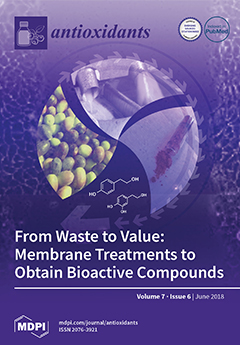Dictamni dasycarpus is a type of Chinese medicine made from the root bark of
D. dasycarpus. It has been reported to show a wide spectrum of biological and pharmacological effects, for example, it has been used widely for the treatment of rheumatism,
[...] Read more.
Dictamni dasycarpus is a type of Chinese medicine made from the root bark of
D. dasycarpus. It has been reported to show a wide spectrum of biological and pharmacological effects, for example, it has been used widely for the treatment of rheumatism, nettle rash, itching, jaundice, chronic hepatitis and skin diseases. In the current study,
D. dasycarpus extract was investigated for its antioxidant and anti-inflammatory effects, as well as its capability to alleviate oxazolone-induced skin damage in mice. The possible anti-inflammatory mechanism of
D. dasycarpus extract against oxidative challenge was elucidated by measuring the levels of reactive oxygen species (ROS) production, interleukin-6, Tumor necrosis factor-α, NLRP3 (NACHT, LRR and PYD domains-containing protein 3 (NALP3)) inflammasome and interleukin-1β in HaCaT cells.
D. dasycarpus extract did not affect cell viability in basal conditions. The extract significantly reduced oxazolone-induced epidermal swelling compared to untreated animal in the hairless albino mice (ICR mice) model. At the molecular level, Western blot assays indicated that the
D. dasycarpus extract attenuated oxazolone-induced activation of apoptosis-associated speck-like protein containing CARD (ASC), procaspase-1, NF-κB and mitogen-activated protein kinase (MAPKs) such as c-Jun N-terminal protein kinase (JNK) and p38. This study demonstrates that
D. dasycarpus extract could protect skin cells against oxidative and inflammatory insult by modulating the intracellular levels of ROS, TNF-α, interleukin-1, interleukin-6, NLR family pyrin domain containing 3 (NLRP3) inflammasome generation, antioxidant enzyme activity and cell signaling pathways.
D. dasycarpus extract also attenuated the expression of NF-κB in HaCaT keratinocytes and thereby effectively downregulated inflammatory responses in the skin. Furthermore,
D. dasycarpus extract alleviated oxazolone-induced damage in mice. Our results suggest the potential application of
D. dasycarpus extract in preventing inflammatory processes in dermatitis.
Full article






